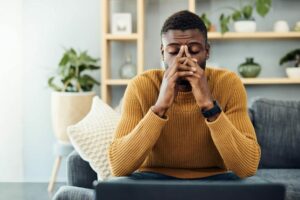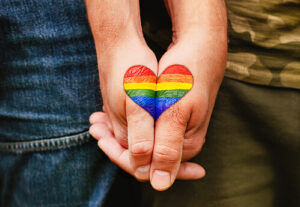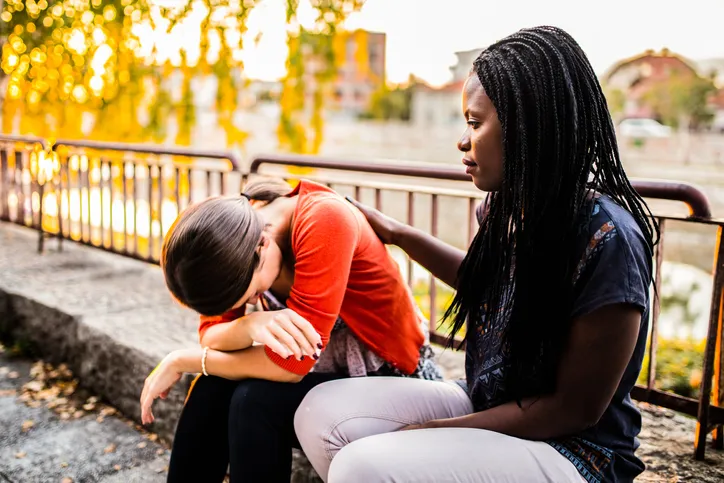In an era of growing acceptance and advocacy for individual identities, we’re still finding that certain groups face unique mental health challenges that require our focused attention. One such group is the LGBTQ+ community, whose members often contend with anxiety at a rate significantly higher than the general population. This blog seeks to explore the connection between LGBTQ and anxiety, aiming to shed light on this important topic while providing practical strategies to manage and mitigate anxiety.
Contents
Understanding Anxiety
 Anxiety is a natural human emotion, characterized by feelings of fear, unease, and worry. It is common to feel anxious when facing challenges or uncertain situations in life. This can range from a job interview to public speaking engagements, or while dealing with stressful circumstances. Normal levels of anxiety can even act as a beneficial motivator, pushing us to solve problems and overcome obstacles.
Anxiety is a natural human emotion, characterized by feelings of fear, unease, and worry. It is common to feel anxious when facing challenges or uncertain situations in life. This can range from a job interview to public speaking engagements, or while dealing with stressful circumstances. Normal levels of anxiety can even act as a beneficial motivator, pushing us to solve problems and overcome obstacles.
However, when these feelings become persistent, overwhelming, and interfere with daily activities, it may signify an anxiety disorder. Anxiety disorders represent a group of mental health conditions that trigger excessive, prolonged, and irrational anxiety responses. These disorders are often characterized by panic attacks, constant worry, avoidance behavior, and physical symptoms such as rapid heart rate, sweating, trembling, and gastrointestinal issues.
It’s essential to recognize that anxiety disorders are not a sign of weakness or failure, but rather complex conditions arising from a mix of genetic, environmental, and psychological factors.
How Are LGBTQ And Anxiety Connected?
The connection between LGBTQ and anxiety is multifaceted and often rooted in the unique social, cultural, and personal challenges faced by these individuals. Understanding this connection requires us to consider several factors:
- Stigma and Discrimination
A significant factor contributing to higher levels of anxiety among LGBTQ+ individuals is the stigma and discrimination they frequently encounter. This prejudice can lead to a heightened state of vigilance or anticipation of future threats, resulting in increased anxiety.
- Minority Stress Theory
This model suggests that the stress experienced by people belonging to a stigmatized minority group, such as LGBTQ+ individuals, can lead to mental health problems, including anxiety disorders. The stress can come from external events (like hate crimes or discrimination), the expectations of such events, the internalization of negative societal attitudes, and/or the concealment of one’s identity.
- Coming Out and Identity Acceptance
The process of identifying and accepting one’s sexual orientation or gender identity, as well as disclosing it to others (known as “coming out”), can be a significant source of stress and anxiety. Fear of rejection, misunderstanding, or hostility from family, friends, or society at large can cause substantial emotional distress.
- Internalized Homophobia/Transphobia
In some cases, LGBTQ+ individuals may internalize negative stereotypes, prejudice, and societal bias against them. Eventually leading to feelings of self-loathing, shame, and anxiety.
- Intersectionality
LGBTQ+ individuals who belong to multiple marginalized identities (for instance, being both queer and a person of color) may face compounded stressors that can heighten anxiety.
It’s important to note that while these factors can contribute to increased anxiety, being an LGBTQ+ individual does not inherently lead to anxiety disorders. However, these unique stressors do indicate a need for tailored mental health resources and supportive environments to help LGBTQ+ individuals manage anxiety and stress effectively.
What Are The Common Signs To Look For?
 Recognizing anxiety, particularly within the LGBTQ+ community, requires understanding that the signs and symptoms can manifest differently across individuals. However, there are several common signs that may indicate the presence of an anxiety disorder. These include:
Recognizing anxiety, particularly within the LGBTQ+ community, requires understanding that the signs and symptoms can manifest differently across individuals. However, there are several common signs that may indicate the presence of an anxiety disorder. These include:
Emotional Symptoms
- Persistent and excessive worry, often about aspects that are disproportionate to the situation at hand.
- Feeling restless, wound-up, or on edge.
- Irritability or quickness to anger.
- A constant sense of impending danger or doom.
Physical Symptoms
- Fatigue, even after adequate rest.
- Difficulty concentrating or a feeling that your mind frequently goes blank.
- Muscle tension or unexplained aches and pains.
- Sleep disturbances, such as trouble falling asleep, staying asleep, or experiencing unsatisfying sleep.
- Rapid heart rate, sweating, shaking, and shortness of breath.
Behavioral Symptoms
- Avoidance behavior, where individuals might avoid certain situations or environments that trigger anxiety.
- Compulsive or repetitive behaviors, like constantly checking things or extreme organization.
Specific to the LGBTQ+ community
- Fear or apprehension about societal attitudes, acceptance, or prejudice related to LGBTQ+ identity.
- Excessive worry about coming out to family, friends, or colleagues.
- Persistent self-doubt or negative self-perception related to sexual orientation or gender identity.
While these signs can suggest the presence of anxiety, they are not definitive proof of an anxiety disorder. If you or someone you know is experiencing these symptoms and they’re causing significant distress or interfering with daily functioning, it’s important to seek professional help from a healthcare provider or a mental health professional. They can provide an accurate diagnosis and guide toward appropriate treatments.
What Are The Impacts Of LGBTQ And Anxiety Together?
The combination of identifying as LGBTQ+ and experiencing anxiety can have several profound impacts, spanning physical, emotional, and social domains:
- Increased Risk of Other Mental Health Disorders
Anxiety often doesn’t occur in isolation and can co-occur with other mental health conditions. Research has shown a higher prevalence of depression, substance use disorders, and suicidal ideation and attempts among LGBTQ+ individuals who also experience anxiety.
- Lower Quality of Life
Persistent anxiety can interfere with an individual’s ability to engage in daily activities, maintain relationships, and achieve their full potential. This may lead to decreased productivity, impaired social functioning, and reduced overall quality of life.
- Physical Symptoms
Chronic anxiety can lead to physical manifestations such as digestive issues, headaches, and a weakened immune system, negatively impacting overall health and well-being.
- Isolation
Fear of discrimination or stigma can lead to social withdrawal, resulting in feelings of loneliness and isolation. This lack of social support can compound mental health issues and make it more challenging for individuals to seek help.
- Relationship Struggles
Anxiety can strain relationships with family, friends, and partners. It may cause individuals to become overly dependent on their relationships or, conversely, push others away due to fear of rejection or misunderstanding.
- Impaired Academic Performance
For young LGBTQ+ individuals, anxiety can impair academic performance and lead to decreased participation in school activities or higher dropout rates.
- Workplace Issues
Anxiety can also negatively impact job performance, productivity, and relationships with colleagues, potentially. Ultimately, leading to job loss or reduced earning capacity.
The impacts of being both LGBTQ+ and having anxiety can be profound, and addressing these unique challenges requires comprehensive support systems, inclusive policies, and mental health resources tailored to the specific needs of the LGBTQ+ community.
How To Deal With Issues Of LGBTQ And Anxiety?
 Dealing with anxiety as an LGBTQ+ individual involves a combination of personal coping strategies, professional treatment, community support, and systemic changes. Here are some strategies:
Dealing with anxiety as an LGBTQ+ individual involves a combination of personal coping strategies, professional treatment, community support, and systemic changes. Here are some strategies:
Professional Help
- Psychotherapy: Cognitive Behavioral Therapy (CBT) is often considered effective in treating anxiety disorders, as it helps individuals identify and change thought patterns that lead to anxiety. Other forms of therapy, like Acceptance and Commitment Therapy (ACT) or Dialectical Behavior Therapy (DBT), can also be beneficial.
- Medication: Certain medications like Selective Serotonin Reuptake Inhibitors (SSRIs), Serotonin and Norepinephrine Reuptake Inhibitors (SNRIs), and benzodiazepines may be used to manage anxiety symptoms. However, they should be taken under the supervision of a healthcare provider.
- Group Therapy and Support Groups: Sharing experiences and coping strategies with others who are experiencing similar challenges can provide emotional support and decrease feelings of isolation.
Personal Coping Strategies
- Mindfulness and Relaxation Techniques: Practices like meditation, deep-breathing exercises, and yoga can help reduce symptoms of anxiety by calming the mind and relaxing the body.
- Regular Exercise: Physical activity can enhance mood and act as a natural stress reducer.
- Healthy Lifestyle: A balanced diet, adequate sleep, and avoiding substances like caffeine, alcohol, and nicotine can help manage anxiety symptoms.
Community Support and Advocacy
- Find Supportive Networks: Connect with LGBTQ+ organizations, online communities, or local groups that provide a safe space to express oneself and receive support.
- Education: Educate yourself and others about LGBTQ+ issues to foster understanding and acceptance. And helps to reduce the stigma and discrimination that can contribute to anxiety.
Policy and Systemic Changes
- Inclusive Policies: Advocate for policies that promote equal rights and protection for LGBTQ+ individuals. This includes policies in schools, workplaces, and government that protect against discrimination based on sexual orientation or gender identity.
- Healthcare Reform: Support healthcare reform efforts to ensure mental health resources are accessible, affordable, and inclusive of LGBTQ+ individuals.
Remember, if you’re struggling with anxiety, it’s crucial to reach out to a mental health professional. They can provide you with appropriate resources and treatment options tailored to your individual needs. It’s okay to seek help, and there are people and organizations available to support you.
Conclusion
Navigating the intertwining paths of identifying as LGBTQ and anxiety can indeed present significant challenges. However, these challenges do not define the entirety of an individual’s identity or potential. Understanding the unique experiences of anxiety within the LGBTQ+ community brings us closer to fostering a society that acknowledges these struggles and actively works to provide the necessary support.
Remember, seeking help is not a sign of weakness, but a testament to your strength and resilience. Together, let’s work towards a world that not only accepts but celebrates diversity in all its beautiful forms. With empathy and understanding as our guiding lights, such a world is within our grasp.
Life may sometimes be challenging for people from LGBTQ community, but Online LGBTQ Counseling can help. Get experienced LGBTQ therapists at PrideMantra: Book a trial LGBTQ therapy session


